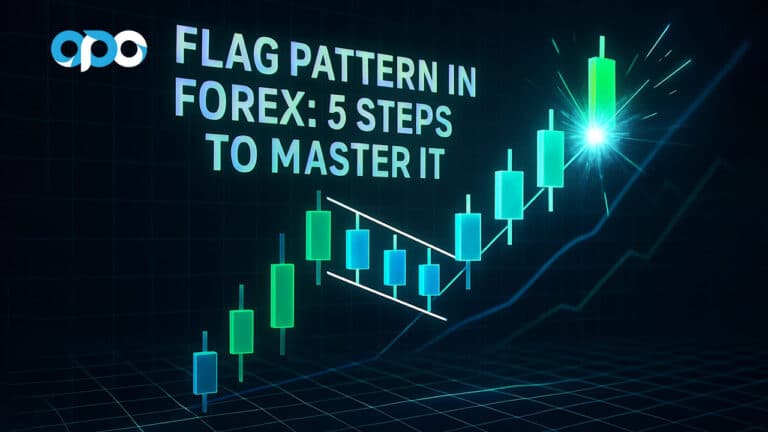Have you ever noticed how the price tag on the same item can feel worlds apart depending on which country you’re in, even after you’ve done the currency math? It’s a common puzzle. Why doesn’t a dollar, euro, or yen buy the same amount of ‘stuff’ everywhere? This is where the concept of purchasing power parity in forex comes into play. It’s an economic idea suggesting that exchange rates should ideally adjust so your money has the same buying power globally for the same goods.
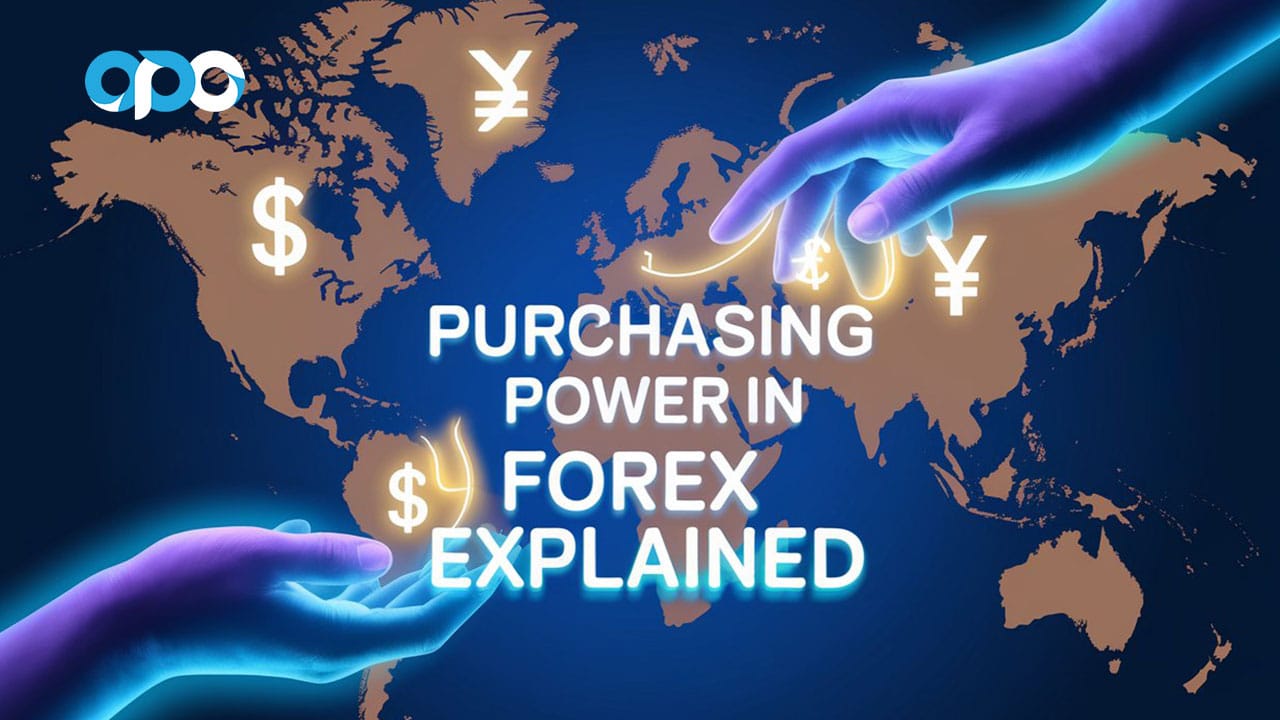
For anyone involved in foreign exchange, perhaps through an online forex broker, understanding this theory is valuable, even if reality often differs. This article will unpack what PPP is, how it works, its different types, and its real-world relevance (and limitations) for the forex market.
What is Purchasing Power Parity (PPP)?
So, what exactly is this Purchasing Power Parity we keep mentioning? Think of it as an economic theory trying to level the playing field for comparing currencies. At its core, PPP suggests that identical goods and services should cost the same in different countries once you account for the exchange rate. Imagine a specific basket of groceries costing $100 in New York. According to PPP theory, that same basket should cost the equivalent of $100 in London, perhaps £80, if the GBP/USD exchange rate is $1.25. It’s about finding an exchange rate based purely on the buying power of currencies within their home countries.
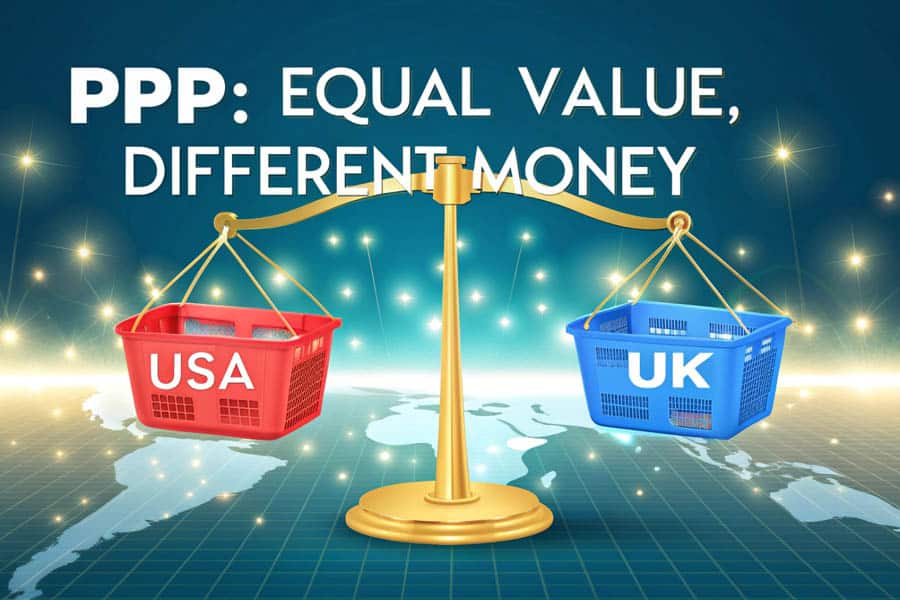
The Law of One Price
The foundation of PPP is a simpler idea called the “Law of One Price.” This law states that if there were no barriers to trade (like tariffs or shipping costs) and markets were perfectly efficient, any identical product sold in different countries should have the same price when expressed in the same currency. If a pair of running shoes costs $120 in the US and €100 in France, the Law of One Price implies the EUR/USD exchange rate should be $1.20.
If the market rate is different, say $1.10, theoretically, someone could buy the shoes in France (€100 = $110) and sell them in the US for $120, making a profit. This arbitrage activity should push the prices and exchange rate towards the $1.20 implied rate. While pure arbitrage is rare in practice, this principle underpins the logic of purchasing power parity in forex.
Dual Application of PPP
Interestingly, PPP isn’t just an exchange rate theory anymore. While it started as a way to think about where exchange rates should go, it’s now widely used by international organizations like the World Bank and IMF for a different purpose: comparing economies. Market exchange rates bounce around due to investments, speculation, and daily news, which can distort how rich or productive a country actually looks. By using PPP-adjusted exchange rates to compare metrics like Gross Domestic Product (GDP), economists try to get a clearer picture of the actual volume of goods and services produced and the real standard of living, stripping away some of that market volatility. This makes PPP a crucial tool for global economic analysis.
Types of Purchasing Power Parity
The general idea of PPP branches into two main versions: Absolute PPP and Relative PPP. They both aim to connect prices and exchange rates, but they tackle it from slightly different angles and have different implications.
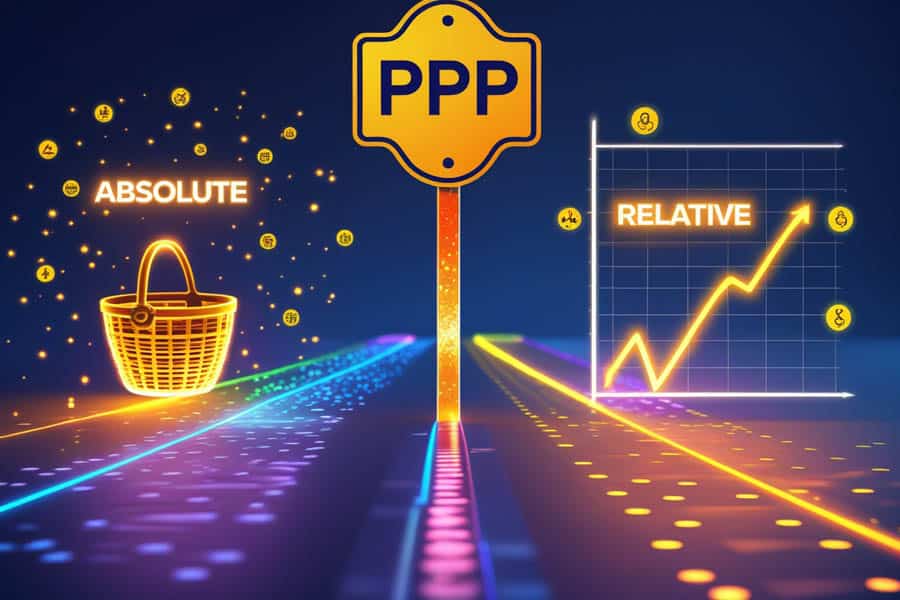
Absolute PPP (APPP)
Absolute PPP is the purist form. It takes the Law of One Price and applies it wholesale to a big basket of goods and services. APPP claims the exchange rate between two currencies should simply be the ratio of the total price of that identical basket in each country.
The basic formula looks like this:
Market Exchange Rate = Price of Basket in Country A / Price of Basket in Country B
For instance, if our defined basket costs ¥15,000 in Japan (Country A) and $100 in the US (Country B), Absolute PPP says the USD/JPY exchange rate should be ¥15,000 / $100 = 150.
Sounds neat, right? The problem is, Absolute PPP almost never holds up perfectly in the real world. Think about all the assumptions: no shipping costs, no taxes or tariffs, completely identical products everywhere, everyone knowing all the prices instantly… it’s just not realistic. Getting a truly identical basket across different cultures and economies is also incredibly tricky. So, while APPP is the theoretical starting point, it’s not a reliable predictor of where the market exchange rate will actually be.
Relative PPP (RPPP)
Relative PPP is a bit more flexible and, many argue, more useful in practice. Instead of focusing on the exact price levels, RPPP looks at the change in prices (inflation) and how that relates to the change in exchange rates over time. It accepts that absolute prices might not equalize but suggests that the difference in inflation rates between two countries should drive the exchange rate movement.
The logic goes like this: if prices are rising faster in Country A (higher inflation) than in Country B, then Country A’s currency is losing purchasing power more quickly. To keep the relative buying power somewhat balanced, Country A’s currency should depreciate against Country B’s currency. The general relationship is often shown as:
% Change in Exchange Rate ≈ Inflation Rate (Country A) – Inflation Rate (Country B)
So, if inflation in Mexico (Country A) is 6% and in Canada (Country B) is 2%, Relative PPP suggests the Mexican Peso should depreciate against the Canadian Dollar by roughly 4% (6% – 2%) over that period. While still facing challenges, especially short-term, RPPP tends to align better with long-term exchange rate trends driven by inflation differences, making relative purchasing power parity in forex a more frequently referenced concept.
How is Purchasing Power Parity Calculated?
Figuring out a PPP exchange rate isn’t as simple as comparing the price of a latte in two cities. It’s a complex statistical exercise involving a hypothetical “basket of goods and services” designed to represent average spending.
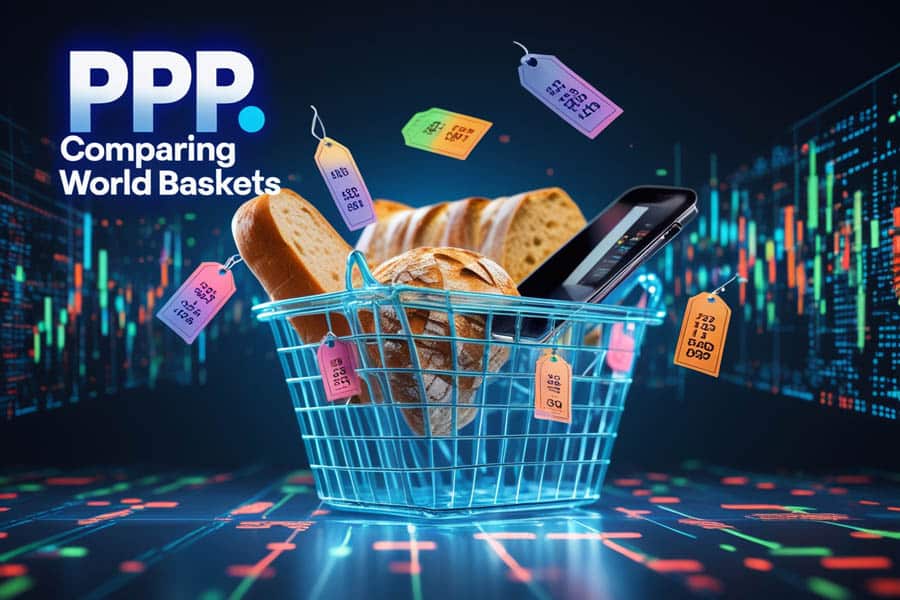
The Basket of Goods Approach
The standard method involves creating a list of common items people buy. International efforts, like the huge International Comparison Program (ICP) run with the World Bank, involve pricing hundreds, even thousands, of very specific items across many countries. This isn’t just “bread”; it’s “1kg loaf of standard white bread, specific type.” The basket covers a wide range:
- Everyday items: Food, drinks, clothes, electronics, furniture.
- Services: Rent, electricity, internet, bus fares, doctor visits, movie tickets.
- Even things like government spending and construction costs can be included.
Data collectors carefully price these items in local currency. The total cost of this basket is then calculated for each country. The PPP exchange rate between, say, the US and India, is found by comparing the total basket cost in dollars versus rupees. This process aims to establish a rate based on actual buying power using a wide array of goods and services, a key part of understanding purchasing power parity in forex implications.
Challenges in Calculation
This sounds straightforward, but the reality is messy:
- What’s in the Basket?: People in different countries buy different things. A staple food in Thailand might be rare in Norway. Creating one basket that fits everywhere is tough.
- Quality Control: Is an “apartment rental” or “car” the same quality everywhere? Adjusting for these differences is subjective and hard.
- Data Gathering: Collecting accurate prices for thousands of items across many locations is a massive job needing lots of resources.
- Things You Can’t Trade: You can’t easily trade a haircut, a local bus ride, or apartment rent across borders. Prices for these “non-tradables” depend heavily on local wages and costs, not international markets, yet they are a big part of living expenses and affect PPP.
- Availability: Sometimes the exact specified item isn’t sold everywhere, forcing substitutions that might not be perfect comparisons.
The Big Mac Index: A Fun Shortcut
Because formal PPP calculations are so complex, The Economist magazine came up with the Big Mac Index as a simple, digestible illustration. The idea is that a Big Mac is pretty much the same burger wherever you buy it globally.
The index compares the price of a Big Mac in local currency, converts it to US dollars, and sees how that compares to the US price. If a Big Mac costs less in, say, Egypt (in USD terms) than in the US, the index suggests the Egyptian pound is undervalued against the dollar based on burger prices. If it costs more, the currency is seen as overvalued.
It’s a quick and often surprisingly insightful glance at currency valuation based on purchasing power parity in forex principles, but it’s just one product. Local labor costs, rent, competition, and taxes heavily influence McDonald’s pricing, so it’s far from a perfect scientific measure, more of a conversation starter.
Purchasing Power Parity and Forex Exchange Rates
So, how does this theory of PPP actually connect with the fast-moving world of forex exchange rates? The link is mainly about the long-term picture. PPP suggests a sort of ‘fair value’ or equilibrium level that market exchange rates should theoretically move towards over time, driven by the relative buying power of currencies.
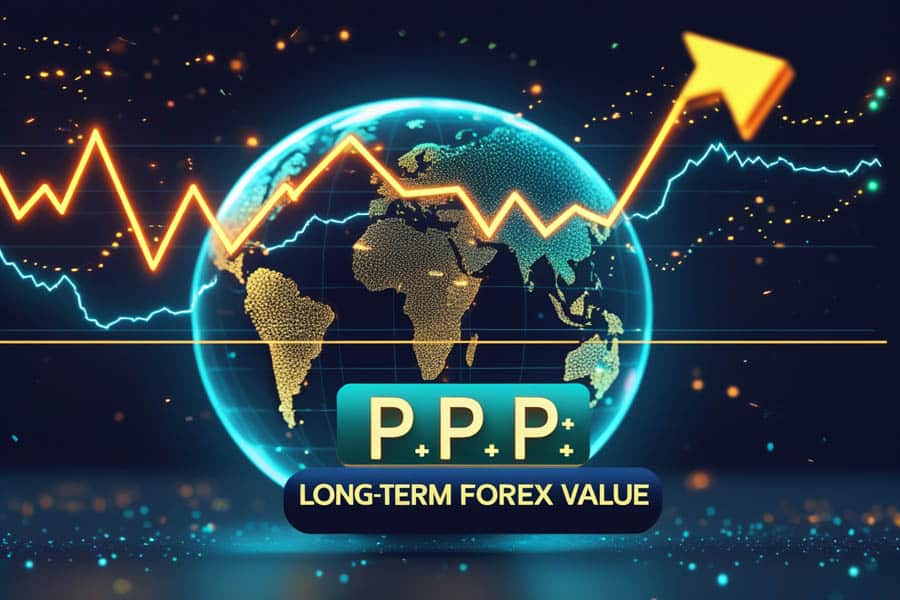
The Theoretical Long-Term Link
The basic idea is that if a currency is way cheaper than PPP suggests (undervalued), meaning goods in that country are a bargain for foreigners, it should eventually lead to more exports from that country. People abroad will want to buy those cheaper goods.
This increased demand for the country’s goods means increased demand for its currency, which should push the exchange rate up, closer to the PPP level. On the flip side, if a currency is too expensive (overvalued), making its goods pricey internationally, exports might fall, imports might rise, and the currency could weaken back towards its PPP value. This self-correcting mechanism is the theoretical heart of purchasing power parity in forex, driven by trade flows seeking the best prices.
Read More:Fundamental Analysis in Forex: Concepts and Effective Indicators
Inflation Differentials and Currency Movements
Relative PPP offers a more dynamic view of this connection. It focuses on inflation – the rate at which prices are rising. If inflation is consistently higher in Country A than in Country B, the currency in Country A is losing its domestic purchasing power faster. To maintain a balance in relative purchasing power between the two countries, the theory suggests that Country A’s currency should depreciate against Country B’s currency by roughly the difference in their inflation rates. This is why forex traders watch inflation reports (like the Consumer Price Index or CPI) so closely. Persistent inflation differences are seen as a long-term driver that can push exchange rates in the direction predicted by RPPP.
Overvalued vs. Undervalued Currencies
One practical way PPP concepts filter into forex analysis is through identifying potentially “overvalued” or “undervalued” currencies. This involves comparing the current exchange rate seen in the market with the exchange rate calculated using PPP methods.
- Undervalued Currency: The market exchange rate makes the currency look weaker (it buys less foreign currency) than the PPP rate suggests. For example, if the market shows 1 EUR = 1.05 USD, but PPP calculations suggest 1 EUR should equal 1.15 USD, the Euro is considered undervalued based on PPP. Goods in the Eurozone would seem relatively cheap to someone converting dollars.
- Overvalued Currency: The market exchange rate makes the currency look stronger (it buys more foreign currency) than the PPP rate implies. If the market rate is 1 EUR = 1.20 USD, but PPP suggests 1.10 USD, the Euro is seen as overvalued. Eurozone goods would appear relatively expensive to dollar holders.
Spotting these differences is a key output of analysing purchasing power parity in forex, but knowing what to do with that information is the next challenge.
Using Purchasing Power Parity in Forex Trading
While PPP gives us a compelling economic theory about long-term currency value, using it directly for day-to-day forex trading decisions is tricky. Most traders find its real value lies in providing background context rather than specific buy or sell signals.
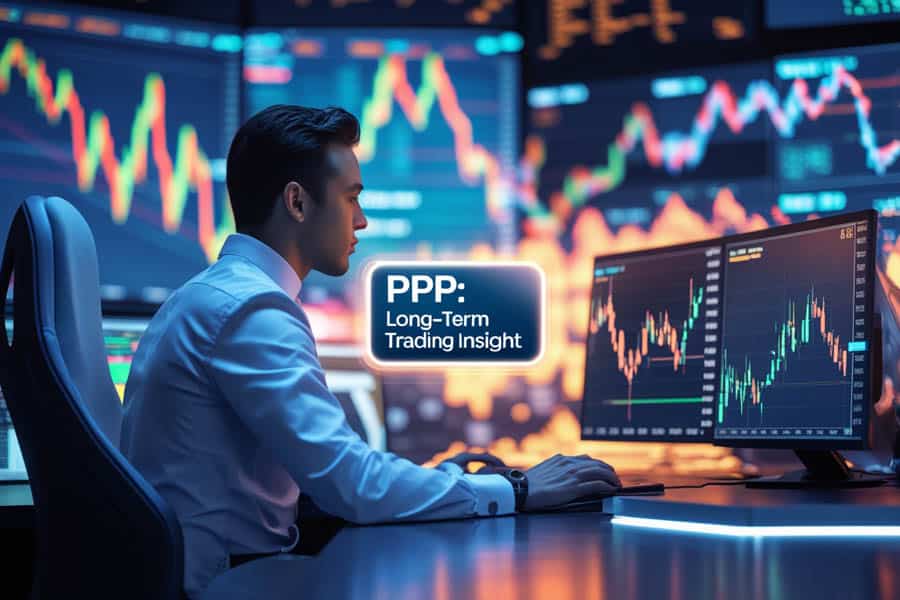
A Long-Term Indicator
Think of purchasing power parity in forex as providing a long-term anchor or benchmark for a currency’s value. It helps traders assess if the current market price seems fundamentally reasonable compared to the relative cost of goods and services. When the market exchange rate drifts very far away from the PPP-implied rate for a long time, it might suggest the currency is fundamentally mispriced and could be poised for a significant correction – eventually. This is a perspective useful for thinking in terms of months, years, or even longer, not minutes or hours.
Identifying Potential Misalignments
Some traders, especially those holding positions for longer periods (position traders) or large funds looking at macroeconomic trends, use PPP data to spot these potential long-term misalignments.
- Potential Long Trades: If a currency looks significantly undervalued according to PPP (say, 20% cheaper than its PPP rate suggests), a trader might see this as a sign it has potential to strengthen over the long haul, forming the basis for a potential long (buy) strategy.
- Potential Short Trades: Conversely, if a currency appears substantially overvalued based on PPP, it might be flagged as a candidate for a long-term short (sell) position, betting on its eventual decline towards the PPP benchmark.
Crucially, this PPP analysis is almost never the only factor. It’s usually combined with looking at interest rate differences, economic growth forecasts, trade balances, political stability, and often technical chart patterns to get a fuller picture and better timing.
Anticipating Corrections (With Caution)
Here’s the big caveat: PPP tells you very little about when a currency might move back towards its theoretical value. Market exchange rates can stay far from PPP levels for years, sometimes even decades! Why? Because in the short to medium term, things like investor sentiment, interest rate changes driving capital flows (‘hot money’), geopolitical news, and central bank actions often have a much bigger impact on exchange rates than the relative price of a basket of goods.
So, using a PPP deviation as your primary reason to enter a trade, especially a short-term one, is generally considered unwise. A currency that looks “undervalued” today could easily get even more undervalued tomorrow and stay that way for a long time. The value of purchasing power parity in forex is more about understanding the deep economic background, less about predicting next week’s price action.
Limitations and Criticisms of PPP in Forex
As helpful as PPP theory can be for understanding economic concepts, it runs into quite a few roadblocks in the real world. These limitations explain why market exchange rates often don’t match PPP predictions, especially in the timeframes most relevant to forex traders.
Why PPP Often Doesn’t Hold
The real world simply doesn’t match the clean assumptions of the theory:
- Trade Barriers: Countries impose tariffs (taxes on imports) and quotas (limits on import volumes) that make goods more expensive and stop prices from equalizing.
- Transportation Costs: Shipping goods across oceans costs money! These costs create a buffer zone where exchange rates can wobble without making it profitable to just buy low and sell high elsewhere.
- Non-Tradable Stuff: You can’t import a haircut, rent an apartment from overseas, or easily use a local bus service from another country. Prices for these local services depend heavily on local wages and conditions, not international trade, yet they’re part of the overall cost of living that PPP tries to measure. This is a major reason why purchasing power parity in forex often deviates.
- Imperfect Markets: Companies might charge different prices in different countries (price discrimination), or face varying levels of competition, affecting prices in ways unrelated to the exchange rate.
- Taxes: Sales taxes or VAT differ greatly across countries, impacting the final price consumers pay, which is what PPP often measures.
- Different Baskets & Quality: It’s tough to compare apples to apples. The “average” basket of goods differs culturally, and ensuring identical quality across borders is a huge challenge. Is a “standard car” really standard everywhere?
- Government Actions: Central banks sometimes intervene directly in the forex market to influence their currency’s value, pushing it away from where PPP might suggest it should be.
- Money Flows & Speculation: This is a huge one. In today’s world, vast amounts of money move across borders for investment (seeking higher interest rates or growth) and speculation, often dwarfing the money flows related to actually buying goods and services. These capital flows are driven by interest rates, risk appetite, and future expectations, frequently overriding the slower-moving forces behind purchasing power parity in forex.
Because of all these factors, PPP remains more of a long-term theoretical concept than a precise predictor of short-term exchange rates. Financial market dynamics often call the shots day-to-day.
Read More:How Interest Rates Affect Forex Market
Enhance Your Trading with Opofinance
Understanding concepts like Purchasing Power Parity is crucial, but successful forex trading also requires the right tools and a reliable broker. Opofinance, regulated by ASIC, offers a robust platform for traders seeking to navigate the complexities of the forex market.
- Advanced Trading Platforms: Choose from industry-leading platforms including MetaTrader 4 (MT4), MetaTrader 5 (MT5), cTrader, and the intuitive OpoTrade platform, catering to various trading styles and preferences.
- Innovative AI Tools: Leverage cutting-edge technology with the AI Market Analyzer for insights, AI Coach for strategy development, and AI Support for assistance, enhancing your decision-making process.
- Social & Prop Trading: Explore opportunities with social trading features to follow experienced traders, or test your skills with proprietary trading programs.
- Secure & Flexible Transactions: Benefit from safe and convenient deposit and withdrawal methods, including popular cryptocurrencies. Opofinance ensures smooth transactions with zero fees charged by the broker for deposits and withdrawals.
Combine theoretical knowledge like PPP with practical tools and a secure trading environment.

Conclusion
Purchasing Power Parity provides a fascinating economic framework for thinking about currency values. At its heart, it suggests exchange rates should ideally reflect the equal buying power of currencies across different countries. We’ve seen how Absolute PPP aims for direct price equation, while Relative PPP links exchange rate shifts to inflation differences. While PPP is invaluable for economists comparing national economies (like GDP PPP adjustments) and offers a theoretical baseline for purchasing power parity in forex, its direct use for short-term trading is fraught with difficulty.
Real-world factors like trade costs, non-tradable services, and especially the huge impact of global capital flows mean market rates often ignore PPP for long stretches. For traders, understanding purchasing power parity in forex is best used as one piece of a larger analytical puzzle, providing long-term context rather than immediate trading signals.
Key Takeaways
- PPP Definition: An economic theory suggesting exchange rates should equalize the price of an identical basket of goods across countries.
- Core Idea: Based on the “Law of One Price,” assuming no barriers or costs.
- Types: Absolute PPP (compares price levels directly) and Relative PPP (links exchange rate changes to inflation differences).
- Calculation: Involves pricing a large, standardized basket of goods/services (e.g., ICP), with challenges in definition, quality, and data. The Big Mac Index is a simplified example.
- Forex Link: Theoretically suggests long-term exchange rate direction based on price/inflation differentials, identifying potential over/undervaluation.
- Trading Use: Primarily a long-term valuation indicator, not a short-term timing tool. Helps identify potential misalignments.
- Major Limitations: Trade barriers, transport costs, non-tradables, capital flows, speculation, taxes, and market imperfections cause significant real-world deviations.
- Overall Value: Useful for long-term economic analysis and as a theoretical benchmark, but must be used alongside other analyses in practical forex trading.
How do sudden economic shocks (like pandemics or energy crises) affect PPP calculations and their relevance to forex?
Sudden shocks can significantly distort both market exchange rates and relative price levels, often causing large, temporary deviations from PPP. For example, supply chain disruptions during a pandemic might drastically increase the price of specific goods in one country but not another, skewing basket comparisons. Energy crises can disproportionately impact inflation in energy-dependent economies. While these events affect the components of PPP, they also drive massive capital flows (e.g., safe-haven demand) that dominate short-term forex movements, making PPP even less reliable as a short-term predictor during such volatile periods. Its relevance might increase later as economies adjust and relative prices stabilize.
Are there alternative theories or indicators traders use instead of, or alongside, PPP for long-term currency valuation?
Yes, traders often supplement or replace PPP with other long-term valuation models. One common approach is the “Fundamental Equilibrium Exchange Rate” (FEER), which estimates an exchange rate consistent with macroeconomic balance (e.g., sustainable current account balance, stable inflation, full employment). Another is the “Behavioural Equilibrium Exchange Rate” (BEER), which statistically models exchange rates based on fundamental economic variables like interest rate differentials, terms of trade, productivity, and net foreign assets. These models attempt to incorporate more factors than just price levels and are often used alongside PPP for a more comprehensive view.
Does PPP work better for certain types of currency pairs (e.g., developed vs. emerging markets) than others?
PPP tends to perform slightly better (though still imperfectly) over the very long term for currency pairs between developed economies with similar structures, open trade relationships, and lower inflation volatility. This is because factors like non-tradable goods and market structures might be more comparable. For emerging market currencies, deviations from PPP can be larger and more persistent due to higher inflation volatility, significant capital controls or interventions, larger non-tradable sectors, faster structural economic changes, and greater susceptibility to risk sentiment shifts and capital flow volatility. Therefore, applying purchasing power parity in forex requires even more caution when dealing with emerging market currencies.






